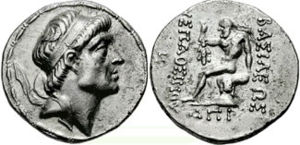- Charax Spasinu
-
Charax Spasinu, or Charax Pasinu, Charax Spasinou (Ancient Greek: Σπασίνου Χάραξ), Alexandria (Greek: Ἀλεξάνδρεια), and Antiochia in Susiana (Greek: Ἀντιόχεια τῆς Σουσιανῆς) was an ancient port at the head of the Persian Gulf, and the capital of the ancient kingdom of Characene.
The exact location of Charax is unknown. The name Charax, probably from Greek Χάραξ,[citation needed]) literally means "palisaded fort", and was applied to several fortified Seleucid towns. One possible site is a large mound known as Jabal Khuyabir or Naisan near the confluence of the Eulaios/Karkheh and the Tigris Rivers. Another possibility is that the town was lost when its dike collapsed and/or one of the rivers in the delta changed course. According to Pliny the Elder:
- "The town of Charax is situated in the innermost recess of the Persian Gulf, from which projects the country called Arabia Felix. It stands on an artificial elevation between the Tigris on the right and the Karún on the left, at the point where these two rivers unite, and the site measures two [Roman] miles [3 km] in breadth. . . . It was originally at a distance of 1¼ miles [1.9 km] from the coast, and had a harbour of its own, but when Juba [Juba II, c. 50 BCE—c. CE 24] published his work it was 50 miles [74 km] inland ; its present distance from the coast is stated by Arab envoys and our own traders who have come from the place to be 120 miles [178 km]. There is no part of the world where earth carried down by rivers has encroached on the sea further or more rapidly. . . ."[1]
Charax was originally named Alexandria, after Alexander the Great, and was perhaps even personally founded by him. After destruction by floods, it was rebuilt by Antiochus IV (175-164 BCE) and renamed Antiochia. It was provided with a massive antiflood embankment almost 4½ km long by Antiochus's governor, Hyspaosines, and renamed "Charax of Hyspaosines."
Although it was nominally a vassal of the Seleucids and, later, the Arsacids, it seemed to retain a considerable degree of autonomy at times. It became a centre for Arab trade, largely controlled by the Nabataeans, at least until they became assimilated by the Romans in 106 CE.
Charax was a rich port with ships arriving regularly from Gerrha, Egypt, India, and beyond. It was also the beginning of the overland trade route from the Persian Gulf to Petra and Palmyra.
It was visited in 97 CE by the Chinese envoy, Gan Ying 甘英, who referred to it as 于羅 (Pinyin: Yuluo; reconstructed ancient pronunciation *ka-ra), who was trying to reach the Roman Empire via Egypt but, after reaching the Persian Gulf was convinced to turn back by the Parthians.[2]
In 116 CE the Roman Emperor Trajan visited Charax Spasinu – his most recent, easternmost and shortest-lived possession. He saw the many ships setting sail for India, and wished he were younger, like Alexander had been, so that he could go there himself.
It was enlarged by an Arabian chieftain, Spasines, and afterward named Spasines and Charax Spasinou after him. [1] It was a major trading center of late antiquity as evidenced by the hoards of Greek coins recovered during excavations there. [2]
Isidore of Charax, a 1st century geographer, came from Charax Spasinu.
Robert Eisenman contends that it was this city, and not the better-known Antioch in which Paul established his first church.
Footnotes
References
- Casson, Lionel. 1989. The Periplus Maris Erythraei. (Translation by H. Frisk, 1927, with updates and improvements and detailed notes). Princeton, Princeton University Press.
- Hill, John E. (2009) Through the Jade Gate to Rome: A Study of the Silk Routes during the Later Han Dynasty, 1st to 2nd Centuries CE. John E. Hill. BookSurge, Charleston, South Carolina. ISBN 978-1-4392-2134-1.
- Nodelman, S. A. 1960. "A preliminary history of Characene." S. A. Nodelman. Berytus 13 (1960), pp. 83–123.
- Potts, D. J. 1988. "Arabia and the Kingdom of Characene." In: Araby the Blest: Studies in Arabian Archaeology. Edited by D. T. Potts. The Carsten Niebuhr Institute of Ancient Near Eastern Studies, University of Copenhagen. 1988. Museum Tusculanum Press, pp. 137–167.
- O. Mørkholm, "A Greek coin hoard from Susiana", in Acta Archæologica, 1965, vol. 36, p. 127-156.
Coordinates: 30°53′41″N 47°34′41″E / 30.894692°N 47.578031°E
Categories:- History of the Middle East
- Ancient Greek sites in Iraq
- Hellenistic colonies
- Former populated places in Iraq
- Populated places along the Silk Road
Wikimedia Foundation. 2010.

